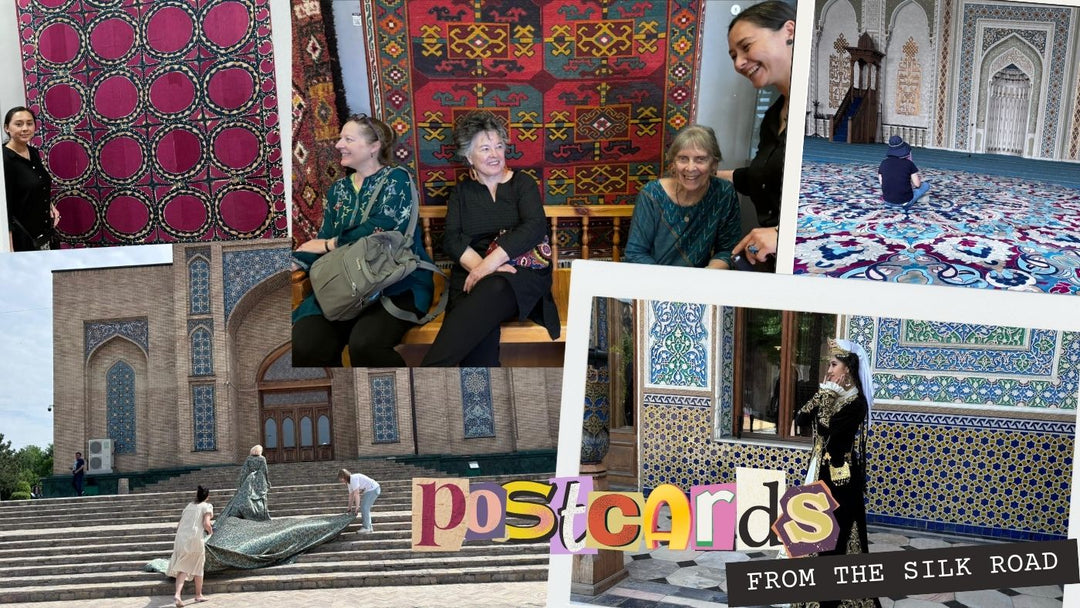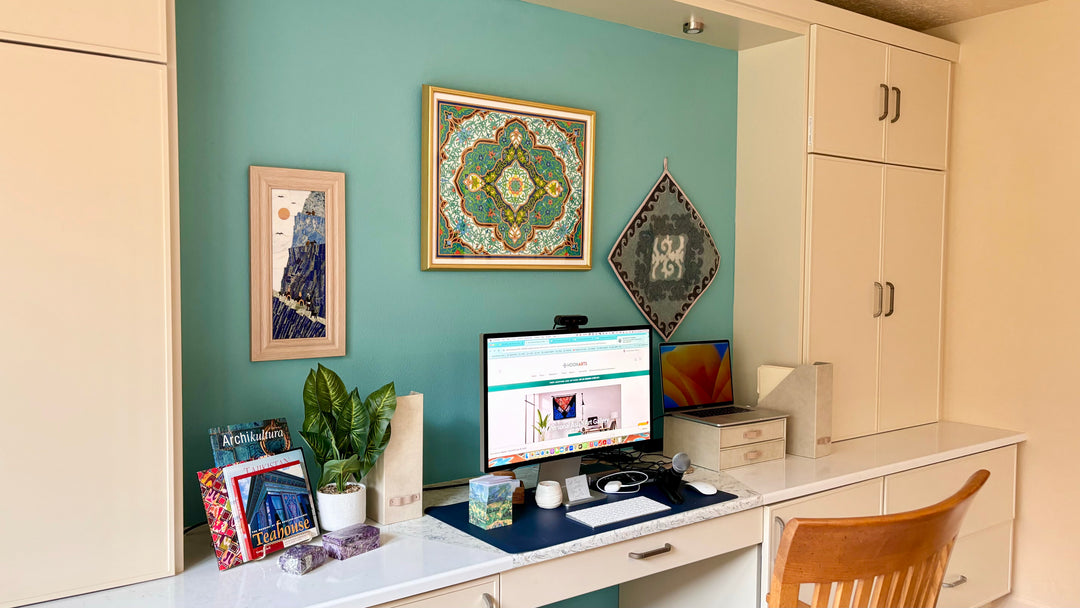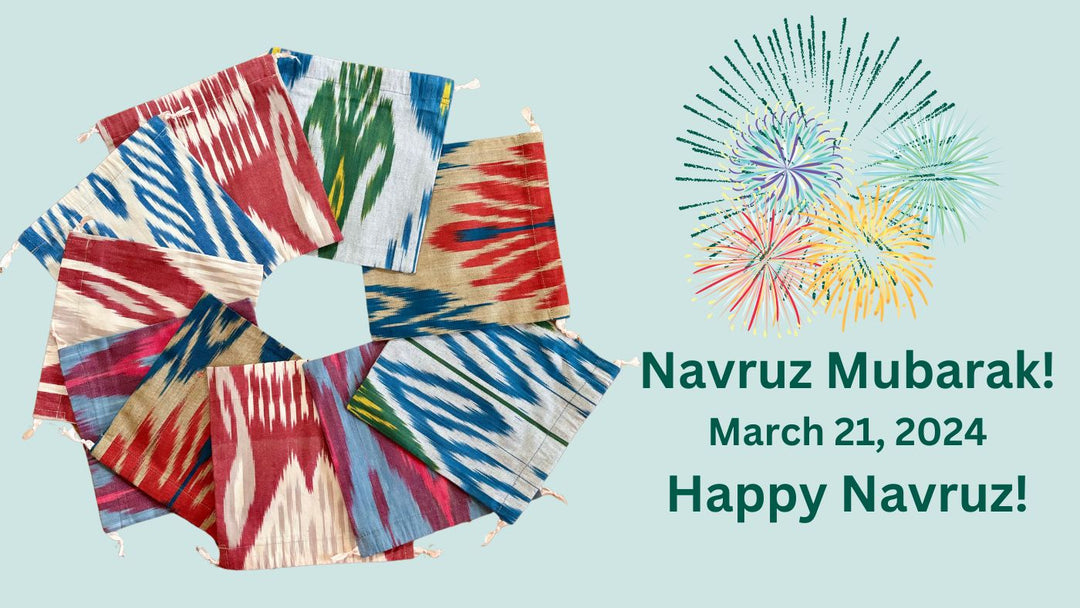Imagine it’s a typical winter in Central Asia. There’s a lot of snow on the ground everywhere. Some of the main roads are closed because of snowpack, accidents, or avalanches. Driving is dangerous even if the roads are “open.” Some of the principal airports in the region are closed. Many rural villages where makers live are temporarily cut off. And the last thing I want to do is jump on a plane to fly halfway around the world to pick up inventory. (And no, Southwest doesn’t fly to Central Asia.)
So just how DOES HoonArts get our beautiful Silk Road products from the makers to you? That’s a frequent question from customers. The next question is usually, “Do you have to go to Central Asia to buy the products?”
In real estate, they say it’s all about “location, location, location.” In the fair trade import world, it’s all about “logistics, logistics, logistics.” In many ways, it’s simple—the same way other commercial sellers get their international products to the US. In other key ways, though, it’s quite complex, because of the geography of Central Asia. The limited extent to which consumer goods made in Central Asia have been integrated into the Western distribution supply chain also makes the whole process more complicated. Patience is critical, which can be challenging in a US market that has been trained by Amazon to expect instant delivery.

To answer the first question, no, I don’t usually go to Central Asia to buy products. Even during our Fall 2022 Three ‘Stans Tour, I visited all my key artists but I brought almost nothing home with me for HoonArts. I didn’t have the space in my small suitcase. Also, I hadn’t ordered ahead so the products I might have wanted to bring home weren’t available right then.
The Order

The logistics issue is a multi-stage process which involves conditions on the ground in Central Asia, HoonArts’ circumstances, and consideration of the fair trade principles governing the way we do business. First, I have to decide what products I want from which artists. This decision is heavily influenced by what types of products have sold well in the past, my current inventory, and upcoming sales events. Once I have a preliminary order plan, then I put together a draft purchase order to discuss with the artist.
Design & Cost
If I'm contemplating new products, we'll often have several Zoom or e-mail conversations to discuss the details and the cost to produce those products. There may also be specific discussions about sizes and other variations of a particular type of product. The cost discussion has to take into account the costs incurred or to be incurred by the artists to produce the products, including a fair wage for the makers and a reasonable mark-up to cover profit and overhead for the artisan business. All those costs have been increasing in Central Asia since the pandemic, just as they have in the USA.
We have to make sure that the final cost and the HoonArts retail markup, which we need to cover our business costs, will not push the price outside the range that American customers are willing to pay. The HoonArts markup varies from product to product, depending upon the cost, including shipping expenses, and the US market for each product. Sometimes, we decide that although we would love to import a particular product, we cannot because we won't be able to sell it at a price that will make sense for US customers or HoonArts.
Production Time & Raw Materials
Then we'll discuss how long it will take to produce those products. HoonArts is not the sole buyer for any of our artisan groups, so the production time for an order is dependent on other orders they're working on, upcoming fairs that they are preparing for, and other work and family commitments. Most of our artisans only work on production part-time.
Often, we have to build into the delivery schedule an allowance to search for and have delivered any of the required raw materials for the products that are not available locally. For example, the base silk fabric for our felted silk scarves from Seven Sisters of Kyrgyzstan is produced by a workshop in Uzbekistan. If Seven Sisters doesn't have the right silk or the right dyes in stock for the color I want, we need to build in extra time to have those raw materials delivered to Seven Sisters in Bishkek.
In Tajikistan, raw materials are a particular challenge. There is only one local cotton factory that produces reliably high-quality cotton fabric that works well with the style of suzani embroidery produced by our embroidery artists at Armughon Handicrafts and Munir. The available colors are also limited. So we often have to change our draft order to reflect what is currently in stock and available at a price that makes economic sense.
If we want to include ikat fabric in a product, searching for the right colors can be even more complicated and time-consuming. If Munira Akilova, as the Tajik designer, needs to import ikat fabric from Uzbekistan, that adds a whole additional layer of complexity and cost.
The embroidery thread used by our embroidery artists in Tajikistan is imported from Russia, because that is the most cost-effective for the high quality that Munira demands. If Munira doesn’t have the right embroidery thread colors in stock, there's an additional delay for that as well. And heaven knows what the current delivery time and availability is given the Russia-Ukraine war.
In Uzbekistan, the ikat weavers produce a particular pattern and color in lengths of approximately 250 meters. That means that if a particular color and pattern is not currently available, I either have to choose an alternate pattern and color from the fabrics in stock or plan on an additional delay for production of the fabric I want. If I’m asking for a unique color, there's the additional challenge of determining whether the artist is willing to produce a custom color without requiring HoonArts to commit to purchase the entire 250 meters.
The Production Process & Supply Chain

Once the raw materials are assembled, our Uzbek and Kyrgyz artists can begin work on the products themselves. In Tajikistan, it's more complicated because many of the embroidery artists are scattered among a number of rural villages in northern Tajikistan. If the embroidery is going to be done by artisans in one of these villages, then Munira Akilova will have to put together kits. The kits will include the base fabric on which the relevant embroidery patterns have been traced, and the correct amounts and colors of the various embroidery threads required for the pattern. Munira has also worked in each section of the pattern a sample of the correct stitch in the proper color to be used in that section.
Once assembled, these kits are sent by Tajik “taxi” to the town closest to the village where the embroidery ladies live. These “taxis” are the Tajik equivalent of Uber cars—private cars operated by individual drivers who provide transportation between towns for people and small packages, but without the app or the centralized scheduling and payment system. When the kits arrive, the local coordinator will pick up the kits and contact the individual embroidery ladies to arrange for pick-up of the kits.
The embroidery ladies then take the kits back home and work on the products when they have time. Most of the village embroidery ladies are homemakers and have families to care for, often as single mothers. Many also have gardening, farming, and livestock projects to manage, in order to keep food on the table. Once the embroidery work is finished, it goes back to Munira in Khujand via the same taxi system. Munira then works with the local tailor/seamstress to assemble the final finished products, including sewing seams, inserting zippers, making linings, hemming, and similar sewing tasks.
The Delivery Chain

Once the entire order is finished, it has to be shipped to the USA. Because all three ‘Stans that we work with are landlocked, there is no easy access to a land or sea route. The nearest ocean is 1000+ miles away, through Afghanistan and Pakistan. It’s even longer going through China or Russia. Consequently, we have to use expensive air freight for all our products, unless someone we or the producer knows happens to be traveling to the USA at the right time and can bring the products with them via “suitcase shipping,” our favorite (and cheapest) shipping system.
The standard air freight system we’ve worked out varies from country to country, but it almost always ends up being a cumbersome and expensive part of our costs. Sometimes shipping can cost over 50% of the cost of the products themselves.
Uzbekistan
Craft Studio IkatUz, which produces our Uzbek ikat-based products, typically uses DHL, which is reliable but always expensive to ship to the USA. Our orders, which are usually small, may be combined with other orders from other shippers and sent to the nearest DHL hub in the USA, which is Phoenix, Arizona.
I learned to my dismay a few years back that a shipment that arrives in Phoenix from Central Asia on Friday will not be processed over the weekend, and it may be Tuesday before the shipment is on its way to Albuquerque. That means, for example, that a particularly large order that had been placed for a biannual weekend show in Albuquerque sat in the warehouse in Phoenix all weekend and didn’t arrive in Albuquerque until the following Tuesday, when the show was over.
Kyrgyzstan
Our Kyrgyz artists, Seven Sisters, usually ship by FedEx. And their products typically come direct to me in individual standard FedEx boxes, without needing to be separated from other orders. I can track my boxes on the FedEx tracking app as they make their way through various FedEx hubs and airports on their way to Albuquerque. I can see where they change planes, where they get processed through customs, and when they finally arrive in Albuquerque. The final step, of course, is delivery to my doorstep. Sometimes the FedEx journey is relatively quick and trouble-free, and other times the boxes get “stuck” somewhere along the way and it takes days to get “unstuck.”
Tajikistan
Tajikistan presents its own unique shipping challenges. Several years ago, the Tajikistani government effectively shut down the international courier services, including UPS, DHL and FedEx. No one in Tajikistan trusts the official government mail service, so that’s not an option either. Fortunately, we connected early on with a shipping company based in Brooklyn, New York founded by a Tajik immigrant, Anvar Jurabaev. Anvar was a childhood friend of Bakhriddin Isamutdinov, our local representative in Tajikistan for artists who do not speak English.
That shipping company, FastEx Shipping, works as a round-trip freight courier service, running one to four or five round trips to Tajikistan every month. (They used to include Moscow in their routes, but I’m not sure what is happening these days in that regard.) The scheduled shipping dates are often canceled or delayed if there isn’t enough business to justify a trip.
All Tajikistan shipping shut down during the pandemic, when the international airport in Dushanbe was closed for over 6 months. We had one order ready and waiting for that entire time with no way to ship. Most FastEx shipments involve sending US products to Tajikistan. HoonArts is one of the few customers that has shipments coming the other direction, back to the USA.
Thus, the Tajikistan shipping process has more moving parts than in Uzbekistan or Kyrgyzstan. So, for example, when Munira has an order ready to ship to HoonArts, she will package it up and deliver it to the FastEx representative in her hometown of Khujand. That agent will then arrange to deliver that package to the representative in Dushanbe, where the international airport is located. Our products will then return with the shipping company’s courier on an international flight to New York. Anvar handles customs clearance and will then repackage individual packages like ours and ship them to Albuquerque, typically by USPS Priority Mail.
And just like here in the US, weather can interrupt the shipping process at any stage. Last winter, for example, I had a big order of hand-carved jewelry and combs that was stuck in a taxi halfway between the makers in Istaravshan and the airport in Dushanbe because there were avalanches on the main north-south highway that caused a 24-hour highway closure. Thank heavens the driver had food and warm clothes to stay safe during that freezing day!
The Giant Jigsaw Puzzle Lives On
I hope this gives you a sense of what goes on behind the scenes when I say the HoonArts business is all about “logistics, logistics, logistics.” As a fair trade company, we eliminate the middlemen product distributors by working directly with the artisans in order to ensure that the artisans receive a larger piece of the retail price. But we still have to deal with the other parts of the production, supply and shipping chain. Each step along the way is a part of a much larger puzzle, which is particularly challenging and expensive in Central Asia. A “blip” at any stage can have major ripple effects throughout the system. This is one of the key reasons that there are only a handful of fair trade companies that work with this part of the world!
But HoonArts is committed to bringing the beauty of the Silk Road 'Stans, and the stories behind our products, to our customers. So we keep working on that giant jigsaw puzzle every day. Thank you for joining us in that effort.







Thanks for sharing this, Rikki! Most people have no idea how complicated it is to get products from their point of origin to the US. I sure didn’t know the details of how it all happens with you! Quite the endeavor! I think it makes each item all the more special….
Happy New Year to you!
Leave a comment